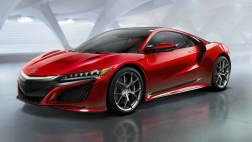Concept cars are a fascinating window into the inner workings of makers, and can be a reliable barometer of health. When Mazda unveils a sportscar study at the Frankfurt Motor Show, it will be just the latest in an impressive series of concepts which demonstrate that design is alive and well at the Hiroshima-based company.
Which is a reassuring sign as Mazda enters the second phase of a renaissance, which began seven years ago. With the launch this week of its new Mazda 2 light car, previewed as the Sassou concept at Frankfurt two years ago, its product overhaul has gone full circle.
If visual appeal is anything to go by, the first of the new generation is encouraging, but few car companies can avoid the cyclical nature of the industry and many turnarounds, such as the one Carlos Ghosn managed at Nissan, soon suffering from fatigue.
Mazda Australia managing director Doug Dickson believes the Japanese maker has left its troubles firmly behind.
“Mazda was always known for innovation and design,” he said at the 2 launch in Queensland this week. “But in the late 1990s we lost our way in Japan when we went through a period of grow or die. Eunos was introduced and other things which didn't work because the Japanese bubble burst, and we didn't have the sales volumes to sustain all the different series we introduced.”
That was when Ford stepped in, increasing its stake in Mazda to more than one-third and moving to restore financial stability. But it also meant throttling the product pipeline while balancing the books.
“Provided we don't go through that exercise again, then what's really happening is just a continuation of a design and engineering-led ethos that's been around since the front-wheel drive 323,” Dickson said.
The first signs of a turnaround appeared in 2000, when Ford put one of its executive high-fliers, Mark Fields, in charge of Mazda with a mandate to restore it to full bloom. Hero cars such as the RX-8 and MX-5 quickly followed but the return to form also turned mainstream models, such as the Mazda 3 and Mazda 6, into showroom hits.
The strong product line-up has been supported by Mazda's distinctive 'zoom-zoom' marketing campaign, which aims to give zest to the whole range. Even people-movers such as the CX7 benefit from this feisty approach.
Despite being one of the first products of this regime, the previous Mazda 2 took a low-risk approach to the light car segment, opting for a cube shape to maximise cabin space and appeal to the Japanese market.
This time there's a single-minded focus on styling and Mazda Australia expects local sales to double to about 850 a month.
If they do, Mazda will have yet another product to reinforce its position as Australia's leading vehicle importer and help it reach a 2010 target of 80,000 sales well ahead of schedule. This year, Mazda Australia expects to retail 75,000 cars for a market share above 7 per cent.
Dickson believes the brand has returned to its glory days with distinctive design its drawcard. “We know that to succeed we have to be different — a little bit unique,” he said.





.jpg)


.jpg)
.jpg)
.jpg)

.jpg)

.jpg)





.jpg)
.jpg)



.jpg)



